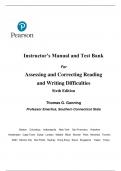M
ED
Instructor’s Manual and Test Bank
C
O
For N
Assessing and Correcting Reading
N
O
and Writing Difficulties
S I
Sixth Edition
E S
Thomas G. Gunning
U
Professor Emeritus, Southern Connecticut State
R
Boston Columbus Indianapolis New York San Francisco Hoboken
Amsterdam Cape Town Dubai London Madrid Milan Munich Paris Montreal Toronto
Delhi Mexico City Sao Paolo Sydney Hong Kong Seoul Singapore Taipei Tokyo
, M
ED
C
O
N
______________________________________________________________________________
N
Copyright © 2018, 2014, 2010 by Pearson Education, Inc. or its affiliates. All Rights Reserved. Printed in the
O
United States of America. This publication is protected by copyright, and permission should be obtained from the
publisher prior to any prohibited reproduction, storage in a retrieval system, or transmission in any form or by any
means, electronic, mechanical, photocopying, recording, or otherwise. For information regarding permissions,
I
request forms and the appropriate contacts within the Pearson Education Global Rights & Permissions
S
Department, please visit www.pearsoned.com/permissions/.
E S
Instructors of classes using Assessing and Correcting Reading and Writing Difficulties, 6e, by Thomas G. Gunning,
may reproduce material from the Instructor’s Resource Manual and Test Bank for classroom use.
U
R
10 9 8 7 6 5 4 3 2 1 ISBN 10: 0134516508
ISBN 13: 9780134516509
www.pearsonhighered.com
ii
, Table of Contents
Preface....................................................................................................................................... iv
Chapter 1: Introduction to Literacy Difficulties ........................................................................ 1
Chapter 2: Factors Involved in Reading and Writing Difficulties .............................................. 3
Chapter 3: Overview of Assessment ...................................................................................... 5
Chapter 4: Placing Students and Monitoring Progress ........................................................... 7
M
Chapter 5: Assessment of Reading and Writing Processes .................................................... 9
Chapter 6: Assessment of Cognitive, School, and Home Factors ......................................... 11
E
Chapter 7: Emergent Literacy and Prevention Programs ...................................................... 12
Chapter 8: Teaching Phonics, High-Frequency Words, and Fluency .................................... 14
D
Chapter 9: Syllabic, Morphemic, Contextual, and Dictionary Strategies ................................ 16
C
Chapter 10: Building Vocabulary.......................................................................................... 18
Chapter 11: Building Comprehension .................................................................................. 20
O
Chapter 12: Reading to Learn and Remember in the Content Areas .................................... 22
Chapter 13: Building Writing Strategies ............................................................................... 24
N
Chapter 14: Tier II and III Programs..................................................................................... 26
N
Chapter 15: Organization of Intervention and Corrective Programs ...................................... 28
Appendix A: The Primary Readability Index……………………………………………………... 30
O
Appendix B: Graphic Organizer Blackline Masters ............................................................... 36
References……………………………………………………………………………………………52
I
Test Bank……………………………………………………………………………………………..53
S S
E U
R
iii
, PREFACE
For each chapter, the instructor’s manual features a Chapter Overview, a series of Learner
Objectives, and suggestions for Before, During, and After Reading. Also featured is a list of
suggested Teaching Activities for each chapter and a Graphic Organizer designed to help
students manipulate key concepts covered in the chapter. The graphic organizers are presented
on blackline masters so that they may be readily photocopied or made into overhead
transparencies. Graphic organizer blackline masters can be found in Appendix B. Included, too,
are suggestions for the Assessment of students’ mastery of each chapter’s key concepts. A Test
Bank contains both selected and constructed responses. Appendix A contains the Primary
Readability Formula, which can be used to estimate the readability levels of materials in grades
1-3.
M
eText Digital Content
E
The 6th edition of Assessing and Correcting Reading and Writing Difficulties is an enhanced
eText and features a Check Your Understanding quiz for each section of each chapter. There are
4 to 6 quizzes in each chapter, some 71 quizzes in all. The quizzes are accompanied by sample
D
responses. Providing strategic stopping places for students to quiz themselves and receive
feedback on their responses, the Check Your Understanding quizzes should foster both
C
increased understanding and retention. As their name suggests, the quizzes are also a means for
checking understanding. If students have difficulty answering the quiz questions, this is an
O
indication that they may need to review the text.
Also featured are video clips. There are 4 to 7 in each chapter for a total of 86. The clips
illustrate assessment and instructional techniques and feature advice and explanations from
N
experts in literacy and related fields. By adding multimedia to printed text, the videos in the
enhanced etext should also foster increased understanding and retention.
N
Before Reading Feature
O
This feature contains suggestions for introducing each chapter. Through discussion or an activity,
it attempts to draw from students’ personal experiences that might be relevant to the chapter’s
main concepts. For instance, before reading Chapter 12, “Reading to Learn and Remember in the
I
Content Areas,” students are asked to discuss their study skills and how they acquired them so
S
they can get a sense of what might be involved in planning and implementing a program of study
skills for struggling readers and writers.
S
During Reading Feature
E
Reminders to encourage students to use SQ3R or another study strategy and text features along
with quizzes and video clips as they read are presented. The topics of the chapter’s video clips
U
are provided.
After Reading Feature
R
A graphic organizer, which specifically requires the reader to organize key concepts, is
presented. The graphic organizer consists of a semantic map, semantic feature analysis, or frame
matrix, which the reader is asked to complete. If students experience difficulty with the graphic
organizer, this could be a sign that comprehension or retention is lacking, so they may want to go
back over the chapter or key parts of it.
Teaching Activities
Teaching activities include a wide variety of suggestions for clarifying, extending, or applying
key concepts in the chapter. The emphasis is on the practical aspects of assessment and
instruction.
Assessment
Performance items and traditional multiple choice and essay questions have been provided as a
iv




